Should you Truss a Chicken or Not?
Some people say you should truss a chicken, and others say don’t bother. In this post I test out both methods side-by-side to compare juiciness, cook time, and more!
Should you truss a roast chicken or not?
This question has been weighing on my mind for a while now because I have heard arguments for both.
The hilarious part is that people say the chicken cooks unevenly if you don’t truss it, yet people say the exact same thing about if you DO truss your chicken. Well my friends, it can’t be both. It just can’t. Reading the same arguments for both options made me bonkers so I decided to test it out on my own, and today I would like to share the results with you.
I went to the store and bought two chickens, of the same brand, and of the exact same weight (they were each 4lb chickens).
I cooked them the same way I cook all of my roast chickens. My roasting vegetables of choice are always leeks, carrots, and parsnips.
I trussed one of the chickens by taking kitchen twine and plumping up the breast, then coming around with the string to lasso the legs and I tied them together:
Then I laid the trussed and untrussed chickens side by side on a bed of vegetables in order to ensure that the chickens would roast in an oven with the exact same temperature conditions.
The skins both turned out more or less the same. Brown and delicious!
But then came the tasting of the meat. My husband and I tasted and compared all the parts of the chicken…the breast, the thigh, the drumstick, the wings…and here’s what we found:
- The trussed chicken’s breast meat was perfectly moist and juicy, while the untrussed chicken’s breast meat was significantly drier.
- The dark meat on the trussed chicken and the dark meat on the untrussed chicken were pretty comparable. They both retained their juiciness and it was hard to notice any differences between the two.
Here’s the fascinating part: When I was checking the chickens for doneness by measuring the thickest part of the thigh, the trussed chicken and untrussed chicken registered at nearly the same temperature, 162 degrees F for the trussed chicken, and 164 for the untrussed. What does this mean? It means we can’t blame the dry breast meat of the untrussed chicken on being from an overcooked bird, because both chickens were cooked to the proper temperature for the thickest part of the thigh. What really happened is by the time the dark meat was done on the untrussed chicken, the breast meat was already long overcooked.
Conclusion: Trussing your chicken not only looks better but yields a more evenly cooked, moister bird. When you don’t truss your chicken, the breast cavity remains wide open and too much hot air circulates inside of it, drying out the breast before the thighs and legs are properly cooked. So always truss those chickens in order to protect the breast and make the chicken a more even mass for roasting.
So tell me, do you usually truss your chicken or not? If you have any comments please leave them below. And here’s my roast chicken recipe:
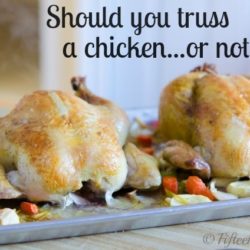
Roast Chicken with Carrots, Leeks, Potatoes
Ingredients
- 4 lb chicken
- 1 lb parsnips chopped
- 1 lb carrots chopped
- 1 large leek sliced
- 2 tbsp olive oil
- lots of salt and pepper
- 2 sprigs rosemary
- 5 sprigs fresh thyme
- 2 garlic cloves smashed
Instructions
- Preheat the oven to 475. We’re starting the oven out really hot to brown the skin of the chicken well.
- Toss the chopped parsnips, carrots, and sliced leek with 2 tbsp of olive oil and a pinch of salt and pepper in a large bowl. Dump the vegetables in a roasting pan or cast iron pan.
- Rub the inside of the breast cavity with lots of salt and pepper, and rub the outside of the chicken all over with salt and pepper as well.
- Stuff the cavity with the aromatic rosemary, thyme, and garlic cloves, then truss the chicken (and don’t forget to tuck the wing tips under themselves so they don’t burn).
- Place the chicken on top of the bed of vegetables and roast in the 475 degree oven for 15 minutes, then lower the oven to 400 and roast for another 40-50 minutes. You want to cook the chicken until it registers at 160 in the thickest part of the thigh.
- Let the chicken rest for 10-15 minutes (you can tent the chicken with aluminum foil to keep it warm), then you’re ready to eat!
Nutrition
Nutrition is estimated using a food database and is only intended to be used as a guideline for informational purposes.

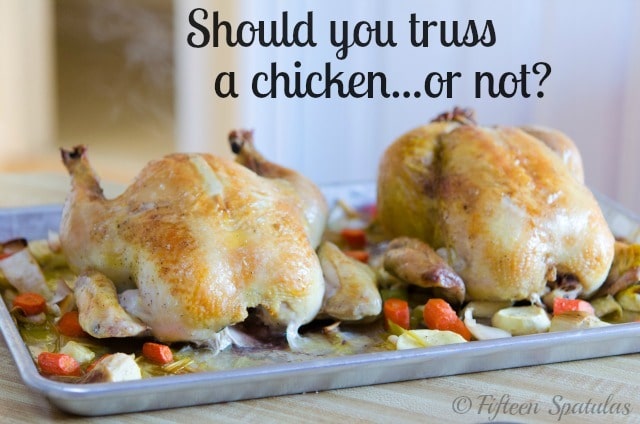
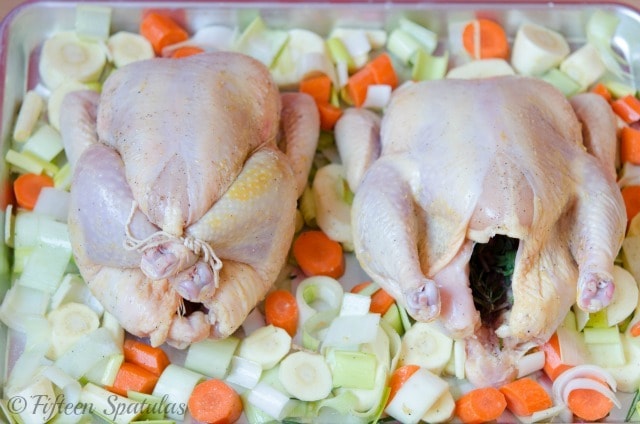
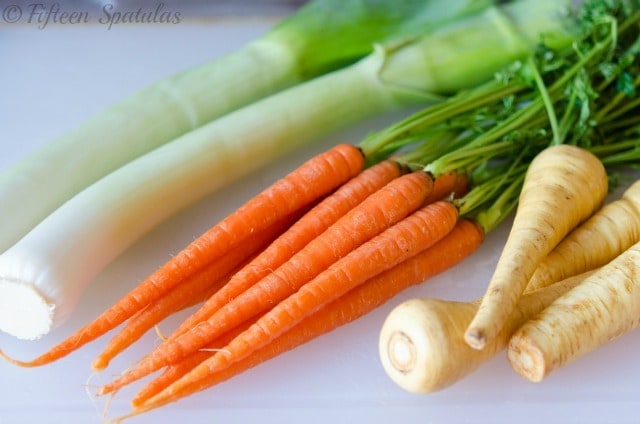
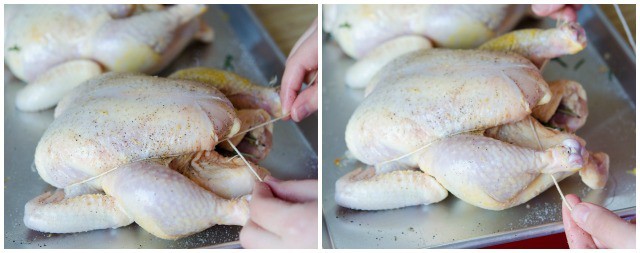
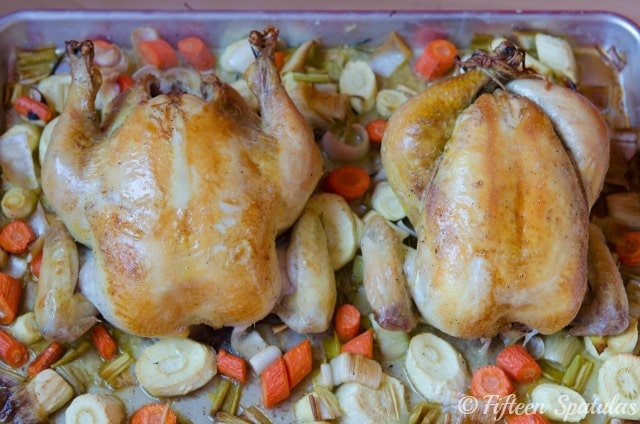

31 Comments on “Should you Truss a Chicken or Not?”
YES! leaving the cavity open WILL cook the meat from the interior and that means it will finish faster. That means less evaporation and drip loss. Alas, you did not check the breast temp and I’ll bet it was overcooked because it cooked faster. Also, I would have preferred you to cook without the veggies, an unregulated variable.
I have LONG stated my preference for spatchcocking which cooks even faster retaining more moisture and browns the interior of the cavity on a grill or if it is on a rack in the oven. Brown is beautiful, the Maillard reaction with more flavor.
Better still: Break ALL whole animals into parts so you can cook each part to its optimium temp, breasts 155-160 and thighs 170 or so.
Meathead, BBQ Hall of Famer
Excellent comparative research! I have been trussing chickens for roasting or spitting for well over 25 years. I use Julia Child’s method, involving two pieces of string, but you need a trussing needle. Your method will work for those who don’t. Result? No doubt about it…. dark meat is equally moist and juicy, but an untrusted chicken has dry unappealing breast meat. The trussed version could not be more flavourful and moist. One other alternative. Take out backbone, salt and pepper very generously inside and out. Dry chicken uncovered in the fridge for an hour or two to additionally dry the skin. Roast spatchcocked in a cast iron pan at 450 for 45 minutes for 3.5-4 lb chicken. Maybe even juicier, and the skin is unbelievably crispy! Yum! 😋
Simple but so flavorful! Love the parsnips.
I never truss but always flatten (butterfly) my chickens. Once flattened, the beast is surrounded by the dark meat and cooks slower so everything cooks to the same temperature at the same time. Also it cooks much faster too! 400 degrees for 40 minutes is all it takes.
I recently started doing this and really enjoy it. Thanks for sharing!
I haven’t trussed before but I will now.
How about a video showing how to truss, then, for the nontrussers out here ;-).
In my 38 years as a chef I’ve often found that you can do either or and get the same end result. A moist chicken. However, everyone’s ovens are different and no two ovens cook alike. In theory though it can be done. At least in my experience is has.
I would say cook them again but this time foil the untrussed chicken after removing it from the oven. (I’m assuming you didn’t initially) I bet you it will come out juicy this time around. I think the biggest mistake people make is after pulling the chicken out of the oven they don’t cover it. Foil is your friend. Use it.
One thing to always remember is that your chicken is still cooking when you remove it from the oven, so by covering it with foil you will keep moisture in. And that will help get you the same results as a trussed chicken.
I don’t truss the bird, but I do fill the cavity with oranges, or lemons, spices; as much as I can stuff in! Apples & raisins with brandy or applejack, naturally moist veggies like mushrooms and onions. Whatever I have on hand. It is safer than stuffing the bird with bread stuffing and the flavor is fabulous.
Thanks for sharing Lisa!
i have been roasting chickens for about a year now, perfecting my technique, and trussing has not worked out for me. i salt and then dry the skin out in the fridge for 36 hours. i bring it up to room temp for 4 hours. i salt and pepper it and truss it. i flash-roast it at 500F degrees for 30 minutes, a crucial step, before cooking another hour at 325. the entire bird cooks perfectly, except for the tied up parts which are downright pink and veiny, a just bit bloody, with all the signs of undercooking. i believe in my method, but i now know that trussing is not right for it at all. old cookbooks from 50 years ago or more have much longer cooking times because meat raised the old-fashioned way took much longer to cook. chefs will tell you that to modernize old recipes you absolutely must reduce cooking times. plus i think flash-roasting may have been far less common, but thats a guess. my point there is that those extended cooking times may have made trussing more necessary, whereas today it can be an outdated and outmoded concept, especially if you flash-roast.. which i HIGHLY recommend
Thank you for answering the question that has been on my mind every time I go to roast a chicken lately. I know my Mother and Grandmothers always trussed theirs but I wondered if it was really necessary. I have a habit of forgetting to cut the string before getting my hands all slimed up. I guess I will just have to learn to do that first thing and keep on trussing.
Yes I always truss. As a food stylist we always were trained this way as well as just the way my Grandmothers cooked all birds. It keeps there shape nice and I believe keeping the wings close to the breast prevents them from drying out.